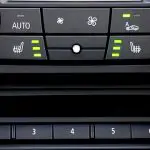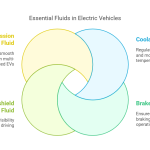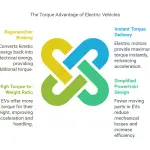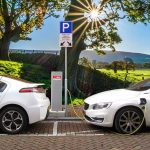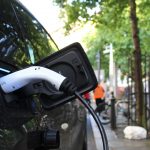Last Updated on January 28, 2025 by
How Does The Heater Work On An Electric Car?
Key Takeaways – How does heat work in an electric car?
Electric cars warm up differently than those with regular engines. Here’s how they do it:
- Heat Pumps: These are like clever air conditioners that can also heat your car. They grab outside air, squeeze it to make it hotter, and then use that heat to warm up the inside of the car or keep the battery toasty. They can also switch to cooling mode when you need it.
- PTC Heaters: Think of these as electric blankets for your car. They use a metal piece that gets hot when electricity runs through it, and then blow air over it to keep you cozy. These heaters are pretty good at not getting too hot on their own.
- Resistive Heating: Some electric cars have a simple system like a hair dryer. They have metal coils that get warm when electricity flows through them, and a fan helps spread that warmth around.
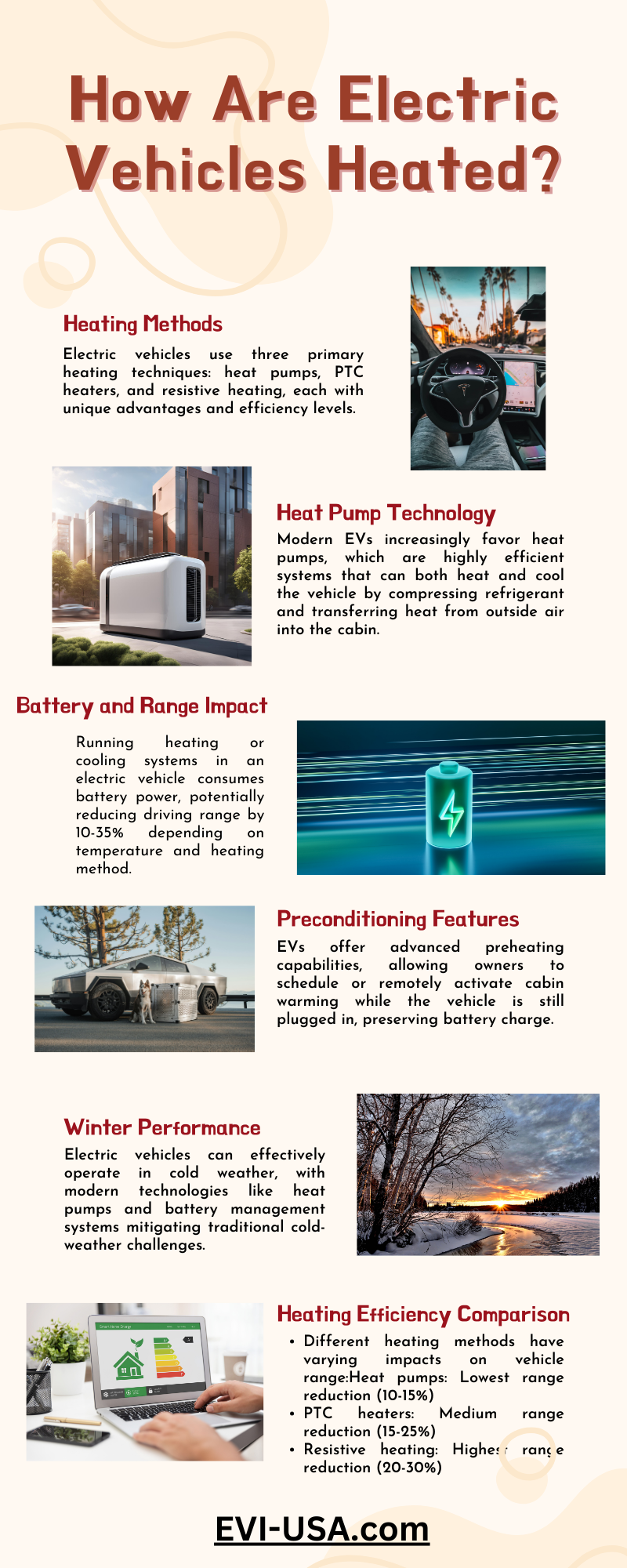
Some electric cars use a mix of these methods. For a quick warm-up, they might start with the resistive heating, but then switch to the more efficient heat pump when you’re ready to drive a longer distance. It’s good to know that running the heat in an electric car will use some of the battery power, so you might not go as far before you need to charge up again. But heat pumps are the smart choice because they use less energy and let you drive farther without getting cold.
How do heat pumps work PDF download

Image by Alex Wray and KM Ebrahimi. Ref: Researchgate – CC by 4.0
EV Heating Technology Update January 2025
Recent technological advances and research in EV heating focus on improving efficiency and range in cold weather conditions:
- Heat pump technology: A study by Recurrent shows that EVs equipped with heat pumps retain 83% of their range at 0°C compared to 75% for those without[3]. This confirms that heat pumps can extend an EV’s range by around 10% in cold climates.
- Integrated thermal management systems: MAHLE is showcasing advanced systems at CES 2025 that combine passenger climate control with efficient thermal regulation of vehicle components, significantly improving EV range and energy efficiency.
- Self-developed thermal management: In June 2023, ZF Group launched a system that potentially increases EV range in winter by up to one-third. It includes an optimized electric drivetrain with 800-volt silicon carbide technology.
- Alternative refrigerants: With upcoming PFAS bans, there’s increased research into new refrigerants that maintain safety and reliability. Hyundai and SK are partnering to develop PFAS-free next-generation refrigerants.
- Artificial Intelligence integration: The industry is seeing increased use of AI and machine learning in designing more efficient thermal management systems.
These advancements aim to address the challenges of EV performance in cold weather, focusing on extending range and improving overall efficiency.
How long can a heated electric vehicle idle?
The duration that a warm electric car can sit still with the heat on depends on a few things like the battery size and how hot it is outside. Generally, they can keep you toasty for quite a while without losing too much power.
For example, a fancy Tesla Model S with a big 100 kWh battery can chill with the heat blasting for up to 12 hours. Meanwhile, a Nissan Leaf with a smaller 40 kWh battery can handle around 4 hours of idling with heat. And get this, a Tesla Model 3 can even go for about 12 hours with high heat or up to 50 hours if you just keep it at room temp.
But remember, electric cars are different from gas cars. They don’t guzzle energy like gas cars do when they’re just sitting. They only use power for stuff like keeping you warm and playing your favorite tunes.
The time you can leave your electric car running with the heat on depends on:
- The size of the battery – bigger is better for longer idling
- The weather outside – really cold or hot can use more juice
- How hot you like it inside – cranking up the heat uses more energy
- How good the car is at saving energy – some models are more efficient than others
In nice, not-too-hot, not-too-cold weather, some electric cars can keep the heat on for over 24 hours and keep the inside at a cozy 72°F (22°C). But if it’s super cold, the heat will use more battery, so it won’t last as long.
In the end, electric cars are pretty good at staying warm while not moving, sometimes even better than gas cars!
Do electric cars have heaters in them?
Yes, electric cars come with heaters to keep you toasty inside! They use special ways to warm up that are different from those in regular cars with combustion engines:
Heating Techniques:
- Simple Resistive Heaters: Think of a small room heater. These have a metal coil that gets hot when electricity passes through, and a fan blows air over it to warm the car. They’re easy to understand but use a good chunk of battery power.
- Smarter PTC Heaters: These are like resistive heaters but better. They automatically adjust so they don’t get too hot, which saves energy and keeps things running smoothly.
- Super Efficient Heat Pumps: These clever devices work like an air conditioner in reverse. They grab cold air from outside, warm it up with a special fluid, and blow it into the car. They’re great because they can heat and cool the car, making them really handy.
Important Points to Remember:
- Electric cars don’t get warm from their engines like gas cars do, so the heating system has to work harder.
- Heating uses battery power, so you might not drive as far when it’s really cold outside.
- More and more electric cars are using heat pumps because they use less energy, so you can drive further without worrying about the cold.
So, even when it’s freezing out there, you can stay cozy in your electric car thanks to these smart heating options!
How do electric cars heaters work
Electric cars keep you warm or cool in different ways than gas-powered cars. Let’s look at the main ways they do this:
To keep you cozy, electric cars might use heat pumps. These are like clever little helpers that pull heat from the air outside, even when it’s cold, and blow it into your car. They also keep your car cool by reversing this trick. Some cars have PTC heaters, which use electricity to warm a piece of metal and then blow air over it to warm you up. They’re pretty smart because they don’t get too hot.
For resistive heating, think of it as running an electric blanket inside your car. Electricity runs through a metal coil, making it hot, and a fan blows that warmth around. It’s not as efficient as a heat pump, but it’s simpler.
When it’s hot outside, electric cars use liquid cooling for their batteries, which is like having a fancy drink that keeps things nice and chilly. They use a special mixture like water with antifreeze that flows through tubes. This is better than air cooling, which is like using a fan, especially when it’s super hot. Air cooling is simpler and cheaper but not as good when it’s really toasty out there.
Some electric cars are clever and use both heat pumps and air cooling together. The heat pump takes care of the main job, while air cooling helps out in extreme temperatures.
Keep in mind that running the AC or heater in your electric car will use some of the battery’s power, so it might make your car go a little less far. But, modern cars are designed to handle this without making a big dent in your driving range. So, stay comfortable and enjoy your ride!
What type of heater does an electric vehicle have?
This table compares three main types of EV heaters: heat pumps, resistive heating, and PTC heaters.
| Heater Type | Efficiency | Range Impact | Advantages | Disadvantages |
|---|---|---|---|---|
| Heat Pump | High | Low (10-15%) | – Energy efficient – Can both heat and cool – Works well in moderate climates | – Less effective in extreme cold – Higher initial cost |
| Resistive Heating | Low | High (20-30%) | – Simple and reliable – Effective in all temperatures – Lower initial cost | – High energy consumption – Significant range reduction |
| Positive Temperature Coefficient (PTC) Heater | Medium | Medium (15-25%) | – Quick initial warm-up – Self-regulating – Compact size | – Less efficient than heat pumps – Higher energy consumption than heat pumps |
Electric vehicles keep you warm with three main heating options:
- Heat Pumps: These are like super cool (or should I say, super warm?) devices that are the best for EVs. They suck in cold air from outside, squish it to make it hot, and then blow it into your car to keep you toasty. Plus, in the summer, they do the opposite to keep you cool!
- Positive Temperature Coefficient (PTC) Heaters: Found in a lot of EVs, these nifty heaters work by running electricity through a metal part, which gets hot. Then, they blow air over it to make the inside of your car cozy. They’re smart too, as they get less power when they’re hot, so they don’t overheat.
- Resistive Heaters: Think of these like a small electric blanket for your car. They have a metal coil that heats up when electricity passes through it. A fan then pushes the warm air around to keep the car cabin snug.
Some EVs mix and match these systems to keep you comfy while using the least amount of power. Heat pumps are the new favorites because they can both heat and cool your ride without making a big dent in how far the car can go on a single charge.
List of popular EVs with types of heater used, power ratings and range reduction
| Vehicle Model | Heater Type | Power Rating | Range Reduction |
|---|---|---|---|
| Tesla Model 3 | Heat pump (newer models) | ~6 kW | ~10-15% |
| Nissan Leaf | Resistive heating | ~5 kW | ~20-25% |
| Chevrolet Bolt | Resistive heating | ~7 kW | ~25-30% |
| Volkswagen ID.4 | Heat pump | ~7 kW | ~10-15% |
| Hyundai Kona Electric | Heat pump | ~5.5 kW | ~15-20% |
| Kia e-Niro | Heat pump | ~5.5 kW | ~15-20% |
| BMW i3 | Heat pump (optional) | ~5 kW | ~15-20% (with heat pump), ~25-30% (without) |
| Renault Zoe | Heat pump | ~4 kW | ~15-20% |
| Audi e-tron | Heat pump | ~7 kW | ~10-15% |
| Ford Mustang Mach-E | Heat pump | ~7 kW | ~10-15% |
Electric car heating system
Electric cars use several heating systems to warm their cabins and maintain battery temperature:
- Heat Pumps: The most efficient and increasingly popular option in modern EVs. They work by:
- Compressing refrigerant to generate heat
- Transferring heat from outside air into the cabin
- Reversing the process for cooling in summer
- Positive Temperature Coefficient (PTC) Heaters:
- Use electricity to heat a metal element
- Blow air over the heated element to warm the cabin
- Self-regulate temperature, increasing resistance as they get hotter
- Resistive Heaters: Less common in newer models but still used in some EVs:
- Pass electricity through a metal coil to generate heat
- Use a fan to distribute warm air throughout the cabin
Heat pumps are becoming the preferred choice for EV manufacturers due to their higher efficiency and ability to both heat and cool the vehicle. They can reduce power consumption for heating by up to 40% compared to other methods when exterior temperatures are below 0°C.Some EVs use a combination of these systems for optimal efficiency. For example, using PTC heating for initial warmth and switching to a heat pump for long-term heating. Additionally, some vehicles utilize waste heat from the motor or battery to supplement cabin heating.It’s important to note that using any heating system in an electric vehicle can affect its range, as these systems draw power from the battery. However, modern systems, especially heat pumps, are designed to minimize this impact on the vehicle’s overall efficiency and range.
How are electric vehicles heated and cooled?
Electric vehicles (EVs) have clever ways to keep you cozy or cool inside, and keep their parts like the battery just right. Let’s talk about these systems:
Heating:
Heat pumps are like little geniuses that keep you warm by squeezing a special gas to make heat, then bringing warmth from outside into the car. When it’s hot, they flip the script and make you cool. These are the go-to choice for most modern EVs.
Then there are PTC heaters, which are like electric blankets. They warm up a metal bit when you turn them on, and the heat spreads out. They’re pretty clever too because they don’t get too hot.
Resistive heaters are a bit old school. They’re like a toaster for your car, using electricity to heat up wires and blowing air over them to warm the inside. They’re simpler, but not used as much anymore.
Cooling:
Liquid cooling is like your car’s personal AC for the battery. It’s great because it keeps things cooler, even when it’s hot outside. It’s a mix of water and something called ethylene glycol that flows around the battery, taking the heat away.
Air cooling is simpler and cheaper, like a fan. It’s used more for the car’s interior, not the battery.
But wait, there’s more! Some EVs have a super cool system that combines all these methods. It’s like a Swiss Army knife for temperature control, keeping everything at the right temperature without wasting too much power.
Remember, running the air conditioner or heater in your EV will use some battery power, so it might not go as far on one charge. But fear not, car makers are working hard to make these systems better, so you can drive more and charge less.
A new test reveals electric cars are practically unusable in winter.
Electric cars don’t have to be good in the snow, but they should be able to handle the cold.
This claim is actually not correct. Electric cars totally work in winter, but they might not go as far or charge as fast when it’s cold outside. Here’s what you should know:
- Cold weather can make electric cars go about 10-20% less on a full charge. Some might even see a 35% drop if it’s really chilly.
- When it’s cold, charging your electric car takes a bit longer, usually around 10% more time than in the summer.
- Different models handle the cold better. Take the Tesla Model Y, it only loses 11% of its range in the cold, while others, like the Skoda Enyaq iV80, can lose up to 32%.
- New tech is helping! Many modern electric cars have fancy systems to keep their batteries happy in cold weather, like heat pumps and better temperature control.
- To get the most out of your car’s battery in winter, you can warm it up while it’s charging, use the seat warmers instead of the car’s heater, and drive at a comfortable speed.
So, calling electric cars “almost useless” in winter is way too dramatic. With a few tricks and knowing your car’s limits, you can drive them all year without much trouble.
How do you heat an electric car in winter before driving off?
Electric cars come with a cool feature to keep you cozy in winter. It’s called preconditioning or preheating, and here’s the lowdown on how it works:
- Scheduling Warm-Ups: You can set a time for your car to get toasty before you hop in. Just tell your car’s computer or use your phone app to pick when you usually leave each day, and voilà, your car will be all warm and comfy like you asked.
- On-The-Spot Heating: If you’re spontaneous and decide to leave earlier or later, no worries! Use the same app on your phone to start warming up your car whenever you want.
- Keep It Plugged In: For the best warm-up, do it while your car is still charging. This means the electricity from the wall outlet is used for the heat, not the car’s battery, so you can drive further when it’s cold.
- Warm Battery, Happy Car: Besides making the inside cozy, preheating helps get the battery to its happy temperature. This makes your car work better and charge faster when it’s chilly outside.
- Frost-Free Windows: No more scraping ice! Your car does the defrosting for you, so you save time and energy in the morning.
- Heat Pumps for Efficiency: Some electric cars have clever heat pumps that use less energy to keep you warm. This is great because it means you can drive more miles without having to charge as often.
So, by preheating your electric ride, you’re not just staying snug, you’re also making sure your car is in tip-top shape for winter driving. It’s all about comfort and getting the most out of your car’s power.
How much can an electric vehicle idle with the AC on?
Electric vehicles, or EVs, can chill with their AC running for a good while without moving. But, just how long they can hang out depends on a few things:
- Battery size: Bigger batteries mean more juice. Take the Tesla Model S with its 100 kWh battery. It can keep the AC on for about 8 hours while doing nothing. On the other hand, a Nissan Leaf with a 40 kWh battery might only manage 3-4 hours.
- AC power use: Most EVs chew through 1-1.5 kWh of energy each hour when the AC is cranked up. On eco mode, it’s like using a 1500 watt hair dryer for 5 hours, which would be about 7.5 kWh.
- How cold or hot you like it: Less AC power means your car can stay put for longer. So, if you’re not a fan of deep freeze or sauna vibes, you can save some battery.
- What kind of car you have: Different EVs are like different appliances; they all use energy differently. Some are more efficient at idling with AC on.
As a rough guide, most EVs can handle 2-5 hours of AC time before they start to feel it in their batteries. For example:
- A Chevy Bolt can stick around for 1-2 hours with AC on before it says “see ya!” and turns off automatically.
- A Hyundai Sonata N-Line can go for up to 3 hours.
Using the AC while you’re not driving does eat into how far your car can go on a full charge, but it’s not a big deal. Like, if you run the AC for 5 hours, you might use about 2.5 kWh, which is like losing 10 miles of driving power.
To keep your car cool without draining the battery too much, it’s a good idea to get it nice and cool before you unplug. Also, don’t blast the AC on full when you’re not moving; that’s just extra work for the battery. Keep it moderate, and you’ll be golden.
What happens to electric cars in traffic jams?
Electric cars are cool in traffic jams! They don’t gulp down energy like thirsty engines do when they’re not moving. Electric cars are like chill couch potatoes, barely using any power when they’re just sitting there. You can let your electric buddy idle for up to two hours and it’ll only lose enough juice for a short trip around the block.
These cars use energy for things like keeping you comfy with heat or AC, playing your favorite tunes, and keeping the lights on, but not too much. And they’ve got clever brains called “battery management systems” that make sure they don’t waste power.
Now, if it’s super hot or freezing outside, it’s like asking a battery to work out in extreme weather – it’ll need a bit more energy to keep everything going. But generally, they handle themselves pretty well in everyday traffic.
Don’t worry about leaving your electric car idle for a bit; it’s totally fine. Just remember, if you leave it running for days without moving, it’s like not giving your phone a break – the battery will wear out faster. So, electric cars are the jam when it comes to jamming traffic, way better than those noisy, gas-guzzling ones!
Do electric cars need to warm up?
Electric cars are different from those with engines that burn gas. They don’t need a special “warm-up” time like the other cars do, but there’s still something you can do to make them even better in the winter. It’s called preconditioning!
Preconditioning is like giving your electric car a cozy blanket and a warm drink before you go out. It’s when you use the car’s built-in heating system to warm the inside and the battery before you drive it. This makes sure everything works really well, like making sure your phone is charged before you leave the house.
Why is this good? Well, a cold battery doesn’t work as well as a warm one. When it’s cold outside, the car might not go as far on one charge if the battery isn’t warm enough. Also, the car won’t charge as fast if it’s cold. By preconditioning, you’re giving your car a head start to perform at its best.
The best part is that you can set up your car to do this while it’s still plugged in and charging. You can even tell it to do this with your phone! It uses a bit of energy, like 2 to 5 of those little energy bars (kWh), but it’s worth it for a nice, toasty car.
If you can’t precondition your car, it’s okay. Just drive it gently for a bit after you start it, like letting it wake up from a nap. It’ll warm up on its own, but it’s a little slower than if you had preconditioned it.
So, electric cars are pretty smart. They don’t need warming up like traditional cars, but a little prep time makes them work better and keeps you more comfortable. It’s all about keeping that battery happy and toasty in the cold weather!
Do electric cars have heaters and air conditioning?
Electric cars have ways to keep you warm and cool, just like your home, but they do it without burning gas! Let’s talk about how they work:
For warmth, some electric cars use something called resistive heaters, which are like those little space heaters that get hot when you plug them in. But, these can use a lot of energy. A smarter way is with PTC heaters, which are like the cooler cousins of resistive heaters. They get hot, but they don’t get too hot because they can tell if it’s warm enough and stop using so much energy. That’s pretty neat!
Now, for keeping things cool, many modern electric cars have heat pumps. Heat pumps are like magic because they take heat from the outside air and make it warmer inside your car when it’s cold. It’s like pulling heat out of the air and throwing it into the car. And guess what? They can do the opposite too! In hot weather, they act like an AC, taking heat from inside the car and pushing it out, but using less power than a regular AC.
The air conditioning in electric cars is a bit different from the ones in cars that run on gas. Instead of using the engine’s power, they have an electric compressor that makes cold air for the cabin. It’s like a mini fridge that keeps your air nice and cool.
Some electric cars are super clever and use one system for both heating and cooling. These cars are like having a best friend who can handle any weather with ease!
So, while electric cars have different parts for heating and air conditioning, they’re getting better at doing both jobs together, which is great for keeping your ride cozy and saving energy at the same time.
How do electric cars cool the interior?
Electric cars keep you cool with a neat system that’s kind of like the air con in regular cars, but it runs on electricity instead of gas. Here’s the lowdown:
- Electric Compressor – It’s like the engine of the AC, but it’s powered by the car’s battery. It doesn’t need the car’s engine to work, so it’s all about electricity!
- Refrigerant – This cool stuff takes the heat from the air inside your car and makes it cold. It changes from a liquid to a gas and back again to keep things chilly.
- Heat Exchanger (Evaporator) – This is where the magic happens. The refrigerant gets cold and sucks up heat from the air, making it cool and fresh.
- Fans – They blow air around the evaporator and across your face, keeping the cool air moving.
- Expansion Valve – It’s like the bouncer of the AC, letting just the right amount of refrigerant into the evaporator to keep the cooling going smoothly.
How it Works:
When you switch on the AC, the electric compressor takes over and starts the cooling party. The refrigerant travels around, absorbing heat from your car and getting cold at the evaporator. Then it goes back to the compressor, gets hot and squished, and the cycle starts again.
Good to Know:
- Electric cars are clever with energy. You can chill your ride while it’s parked without using much battery power.
- Some have heat pumps that work like a two-in-one deal, giving you warmth in winter and coolness in summer.
- These systems are quick to cool you down and can work without the car being on, which is handy for prepping your ride for comfort before you start driving.
So, electric cars come with fancy AC that’s great for keeping you comfortable and doesn’t guzzle down your car’s energy like a thirsty elephant. It’s all part of their clever design to save energy and keep you happy on the road!
FAQ relating to How are electric vehicles heated?
Do electric cars work in extreme cold?
Electric cars totally work in the cold, but they might not go as far or feel as peppy when it’s super chilly. Here’s the lowdown on how these cars behave in winter:
- Less Juice in the Battery: When it’s really cold, say around zero degrees, electric cars can go about 10% to 30% less distance on a full charge. It’s like your phone battery draining faster in the cold.
- Slower Battery Work: Cold weather makes the chemical party inside the battery go a bit slower. This means the car might not have as much oomph or go-power as it usually does.
- Warming Up Your Ride: Electric cars use battery power to heat the inside, so that takes away from how far you can drive. It’s like using your phone’s battery to keep warm and then having less to talk.
- Pre-Warming Perks: If you warm up your car while it’s still plugged in, it’s like giving your battery a cozy blanket and a warm cup of tea. It helps it work better and doesn’t use up the car’s energy, keeping your drive range longer.
- Still Good to Go: Modern electric cars, like the Tesla Model Y, can still take you over 100 miles in the cold. Some do better than others, just like people in winter clothes.
- Temporary Setback: Don’t worry, the cold doesn’t hurt the battery permanently. Once it’s warmer, your car’s range will bounce back like a yo-yo.
- Charging in the Cold: It might take a bit longer to charge your car in cold weather, but most of them come with clever features to make it work without freezing your butt off.
So, even though electric cars aren’t immune to the cold, with a little know-how, they can still get you around town without leaving you out in the chilly air. Keep them cozy and charged, and you’ll be set for winter driving!
How long does it take an electric car to charge?
The time it takes to charge an electric car is like charging your phone, but it depends on a few things. It’s affected by the size of the battery, the kind of charger you’re using, and how much charge the battery already has. Let’s look at charging times in a simple way:
Home Charging (the slow and steady kind):
Using the regular power outlet at home, like the one you plug your phone into, can take up to a whole day to charge your car, especially if the battery’s really big.
Faster Charging (Level 2):
When you use a more powerful home charger or one at public spots, it’s quicker. It can take between 4 to 8 hours to fully charge your car, like charging your phone overnight.
Super-Fast Charging (DC Fast Charging):
These are like the turbo chargers you find at some stations. They can fill your car’s battery from empty to almost full in just 30 minutes to 1 hour. Imagine, a quick pit stop for a coffee and your car’s ready to go!
Ultra-Super-Fast Charging (Ultra-Rapid Charging):
These are the fastest ones out there, charging your car from really low to most of the way full in 15 to 30 minutes. It’s like getting a top-up for your phone battery in no time!
Now, a few things that can make charging take longer or shorter:
- Battery Size: Bigger batteries are like bigger phones; they take longer to charge.
- How Empty Your Battery Is: If it’s almost empty, it’ll take longer than if it’s just a bit low.
- Your Car’s Charging Limit: Some cars can’t suck in power as fast as others, so they’ll charge more slowly.
- Charger Strength: The more power the charger can give, the quicker the car charges.
- Weather: Just like your phone gets warm when it charges fast, so does the car. So, in very hot or cold weather, it might charge a bit slower.
Remember, electric car charging times can change based on these factors, but the good news is that charging tech keeps getting better, making it easier and quicker to keep your car running.
Does AC drain electric car batteries?
Yes, using the AC in electric cars does use up some battery juice, but it doesn’t suck it dry! It takes about 1.5 to 2 kilowatts of power to run the AC, which can mean going a bit less distance on a single charge. For instance, you might see a drop in how far you can go by 10-20% when you use it.
Now, if it’s hot outside and the AC is working overtime, it could mean you can’t drive as far as you’d like, maybe even up to 30% less. It’s like your car’s battery is working harder to keep you cool. And unlike gas cars that can use heat from the engine to warm the car, electric vehicles rely solely on the battery for both cooling and heating, which can affect how far you can drive.
But here’s the deal: many electric cars come with clever features like heated seats that use less energy than blasting the AC or heat. These options can keep you comfy without making your car’s battery work too hard.
And hey, there’s a cool trick called preconditioning! It’s like giving your car a little AC or heat bath before you take off. You can set your car’s climate control while it’s still charging so it uses the electricity from the plug instead of the battery. This way, you get into a nice, comfortable ride without losing too much range.
Don’t worry, though! Modern electric cars are pretty smart at handling power use. They’re designed to keep you cozy without messing up your car’s performance too much. So, while the AC will use some energy, it won’t ruin your driving experience. Just be mindful and plan ahead, and you’ll be cruising along just fine!
How many years will an electric car last?
Yes, using the air conditioning (AC) in electric cars does use up some of the battery’s power, but how much really depends on a few things. Here’s the deal:
- The AC can use a fair bit of juice – think about 1.5 to 2 kilowatts (kW) of energy, which is like using a couple of strong hair dryers at the same time. This can make your car’s battery go down faster, and you might notice you can’t drive as far on one charge, especially when it’s really hot outside.
- Driving range might drop a bit – with the AC working hard, you might find you can drive 10 to 20% less before you need to plug in again. If it’s super hot, it could be even more, like 30%.
- Heating and AC are both power-hungry – both heating and cooling take energy from the battery. Electric cars don’t get extra warmth from a gas engine, so they have to work harder to keep you cozy.
- There are clever ways to stay warm or cool without using too much power – some electric cars have heated seats that use less energy than blasting the heat or AC. It’s like having a warm blanket that doesn’t make your car’s battery sad.
- Cooling your car before you go can help – if you set your car to cool down while it’s still charging, it doesn’t use up the battery power you need for driving. That way, you’re nice and comfy without losing too much range.
So, yes, the AC will make your electric car battery work a bit harder, but modern cars are pretty good at managing this. If you’re smart about it, you can stay cool (or warm) without worrying too much about running out of charge.
SUMMARY
Electric cars have some cool ways to stay toasty in the cold winter months. They use things like heat pumps, which are like little helpers that grab warmth from outside and bring it inside the car. Then there are PTC heaters that warm up a metal part using electricity, kind of like how your toaster works. And resistive heaters are like small, car-sized heaters that heat the air directly.
Now, let’s talk about keeping the warmth going for a long time without using too much battery. It’s like having a big or small battery pack for your phone. A Tesla Model S is like having a big battery pack; it can keep you warm for up to 12 hours without driving! On the other hand, a Nissan Leaf has a smaller battery pack, so it’s more like a medium-sized pack, giving you around 4 hours of heat.
But here’s a neat trick: if you prep your car before you drive, by warming it up while it’s still charging, you can make the most of your battery and be super cozy. This is called preconditioning, and it’s like giving your car a warm-up hug before you hit the road. It’s good for the battery and makes sure you’re nice and warm before you go. So, electric cars can keep you all snug and warm, you just have to know how to use them right!
Resources
- Lavender Oil - February 2, 2025
- Electric Cars with Solar Panels On Roof: The Future of Sustainable Driving - January 29, 2025
- Best Cheapest Electric Car Reddit Comments - January 23, 2025

